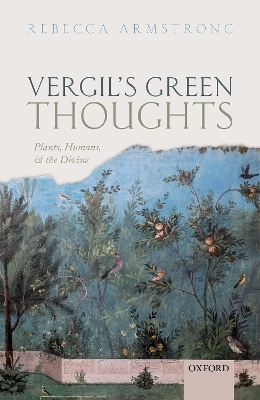
Vergil's Green Thoughts
Oxford University Press (Verlag)
978-0-19-923668-8 (ISBN)
The Eclogues, Georgics, and Aeneid abound with plants, yet much Vergilian criticism underestimates their significance beyond attractive background detail or the occasional symbolic set-piece. This volume joins the growing field of nature-centred studies of literature, looking head-on at Vergil's plants and trees to reveal how fundamental they are to an understanding of the poet's outlook on religion, culture, and mankind's place within the world.
Divided into two parts, the first explores the religious and more diffusely numinous aspects of Vergil's plants, from awe-inspiring sacred groves to divinely promoted fields of corn, and shows how both cultivated and uncultivated plants fit within and help to shape the complex landscape of Vergilian (and, more broadly, Roman) religious thought. In the second half of the book, the focus shifts towards human interactions with plants from the perspectives of both cultivation and relaxation, exploring the love-hate relationship with vegetation which sometimes supports and sometimes contests the human self-image as the world's dominant species. Combining a series of close readings of a wide range of passages with the identification of broader patterns of association, Vergil's Green Thoughts appositely reveals and celebrates the complexity and variety of Vergilian flora.
Rebecca Armstrong is Associate Professor in Classical Languages and Literature at the Faculty of Classics of the University of Oxford, and Mary Bennett Fellow and Tutor in Classics at St Hilda's College. She grew up in rural north Devon before coming to Oxford to study, and took up her current posts in 2004. She now lives in rural north Oxfordshire.
0: Introduction
0.1. Ancient botany and ways of seeing plants
0.1.1. Definitions of nature
0.2. Humans and plants: from anthropocentrism to ecocriticism
0.2.1. Plants and an anthropocentric world-view
0.2.2. Ancient environmentalisma
0.2.3. Ecocriticism and ancient literature
0.3. Gods and plants
0.3.1. Approaches to numen
0.3.2. Plants and everyday religion
0.3.3. Forms of association: nymphs and trees
0.4. Plants as symbol and metaphor
0.4.1. Plants, people, and analogy
0.4.2. Plants and politics
0.5. Poetic plants
0.5.1. Poetic plants before and beside Vergil
0.5.2. Plants and poetics in Vergil (a glimpse of a road not much taken)
I: Numen
I: Numinous Habitats
I.1. Forests and woodland areas (silua, saltus, nemus, lucus)
I.1.1. Backgrounds
I.1.2. Habitarunt di quoque siluas: gods and woods in the Eclogues
I.1.3. Present and absent numen in the woods of the Georgics
I.1.4. Religio dira loci: the Aeneid's woodland numen
I.1.4.1. Underworld woods: numen and confusion
I.1.4.2. Echoes of the underworld: Aeaea, Tiber, Albunea, Amsanctus
I.1.4.3. Woodland numen and the city
I.2. Numen and plants in cultivated land: fields, meadows, plantations, and gardens (ager, aruus, campus, nouale /-is, pratum, rus, seges, arbusta, hortus)
I.2.1. Expected and unexpected agricultural divinity in the Eclogues and Aeneid
I.2.2. Ceres, Bacchus, corn, and vines in the Georgics
I.2.3. Plants and divine metonymy
II: Gods' Special Species
II.1. Oak (aesculus, quercus, robur, and ilex)
II.1.1. The oak transformed: votive tree and trophy
II.2. Poplar (populus)
II.3. Pine (pinus, picea)
II.4. Olive and wild olive (oliua, oleaster)
II.5. Laurel / bay (laurus)
II.6. Myrtle (myrtus)
II.7. Cypress (cupressus, cyparissus)
II.8. Ivy (hedera)
II.9. The borderline divine: magical and medicinal plants
II: Homo
III: Tame Plants
III.1. Symbiosis
III.1.1. Harmonious work in the Eclogues
III.1.2. The locus amoenus and other harmonious habitats
III.1.3. Grain and other field crops: shared endeavour and shared suffering
III.1.4. Useful trees
III.1.4.1. Useful trees and the exotic
III.1.5. Productivity at a price: the vine
III.2. Conflict
III.2.1. Too much of a good thinga Farming as restraint of nature
III.2.2. Farming as violence
III.2.2.1. Vines and violence
III.2.2.2. Grafting: art or abusea
III.2.2.3. Cultivation and violence: metaphor in reverse
IV: Wild Plants
IV.1. Defining the wild
IV.1.1. Flowers: wild yet tame, tame yet wild
IV.1.1.1. Flowers and bees
IV.1.1.2. Flowers and people: beauty, sex, and death
IV.1.2. Wildness and spontaneous production in trees
IV.1.3. Degeneration and degeneracy
IV.2. Weeds
IV.2.1. Weeds and further questions of definition
IV.2.2. Characterizing weeds
IV.2.3. Intermediate weeds
IV.2.4. Crossing (and making) boundaries with brambles
IV.2.5. Grass: from harmony to danger
IV.3. Fighting and felling: a coda
V: Conclusions
Endmatter
Works cited
Index of plants
Index of passages discussed
General index
| Erscheinungsdatum | 29.08.2019 |
|---|---|
| Verlagsort | Oxford |
| Sprache | englisch |
| Maße | 160 x 242 mm |
| Gewicht | 638 g |
| Themenwelt | Geisteswissenschaften ► Sprach- / Literaturwissenschaft ► Anglistik / Amerikanistik |
| Geisteswissenschaften ► Sprach- / Literaturwissenschaft ► Literaturwissenschaft | |
| ISBN-10 | 0-19-923668-2 / 0199236682 |
| ISBN-13 | 978-0-19-923668-8 / 9780199236688 |
| Zustand | Neuware |
| Haben Sie eine Frage zum Produkt? |
aus dem Bereich


